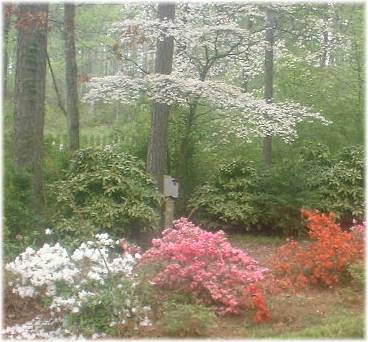|
Gardens Ablaze |
||
|
|
Azalea
|
|
|
Detailed Shrub & Hedge Plant Profiles Site Map
Home
|
All Azaleas belong to the genus Rhododendron, with evergreen type and deciduous types each classified as a subgenus. With something like 10,000 different registered names, one would be correct in assuming that there are marked differences in cold hardiness, size, shape, color, bloom sizes, blooms dates, and even heat tolerance in this huge group of plants. As such, there is undoubtedly a perfect azalea out there for even the most discriminating gardener. As with most any garden plant, best way to choose an azalea for your location is to go take a look at what local nurseries have to offer. They have done all the leg work and sell what does well in your area, leaving you with only the delightful tasks of choosing color (white, pink, red, purple, orange, and yellow - and some bi-colors), and deciding where to place them in your landscape.
Azaleas have delicate root systems and will absolutely not survive in dense clay or areas that don't drain well. Prepare the soil thoroughly before planting your Azalea, digging a generous hole and amending the soil with a good quality topsoil. Tease the roots of the Azalea or spray the root ball with a forceful stream of water to loosen it up. The plant will never grow or expand if you skip this step. Don't plant any deeper in the soil than the plant was originally seated in the pot. Planting too shallow is actually better than planting too deep. Azaleas do best in slightly acidic soils, so if you are in an area that has alkaline soil or if the area has been limed at any point in the last few years, you may have to add a small amount of iron sulfate to the surface of the soil. Do this a little bit at a time and observe. You definitely don't want to overdo. Once planted, water your Azalea in well. No fertilization is needed at planting time. As light feeders, Azaleas don't need much in the way of fertilization through the year, but for the best blooms the following year, do give them a feeding with an acid-type fertilizer just after they finish flowering in the spring. There are many brands of fertilizer formulated just for Azaleas that take the guesswork out of choosing. Look for a label that says it's formulated specifically for Azaleas, Camellias, and Gardenias. Although Azaleas don't require much pruning, they actually take pruning quite well, and in my neighborhood, there are some really beautiful Azaleas trimmed as hedges. The trick is to prune just after flowering, and never later than mid summer, or you will be cutting off next year's flowers. Azaleas are highly poisonous, so if you have them in your yard, take care around them, especially with small children. Most domestic pets seem to know to steer clear, and I haven't run into any accounts of dogs or cats becoming sick or dying from ingesting Azaleas, so in most cases, and with proper knowledge, most of us can plant them in our home landscapes with little fear of harm to our pets. However, for those with puppies or dogs who are real chewers it may be prudent to use Azaleas only in areas where the pets can't go until they grow out of the chewing phase. Lastly, many types of Azalea make great flowering Bonsai specimens. If you happen to acquire an Azalea Bonsai, be sure to check the soil regularly and water by putting it in the shower for a few minutes or letting it sit in the sink for a while until it soaks up enough water to moisten the soil thoroughly. Place the plant outside for at least half a day every day (remember, this is at heart an outdoor shrub), and when inside, give it a sunny window. More information on Azaleas is available in the Gardening QA Section. Click here to see what other gardeners are asking.
Custom Search
|
|
|
Gardens Ablaze |
||
 In
the world of flowering shrubs, there's no substitute for the awesome azalea.
In the south, just about every town has a traditional festival or scenic
walk devoted to viewing azaleas in full bloom in the spring, and I can tell
you, it is an awesome sight.
In
the world of flowering shrubs, there's no substitute for the awesome azalea.
In the south, just about every town has a traditional festival or scenic
walk devoted to viewing azaleas in full bloom in the spring, and I can tell
you, it is an awesome sight.  The
location and method for planting Azaleas will make the difference between
success and failure. Azaleas will not do well in dense shade and though
they may survive full sun, their flowers are likely to bleach and be less
attractive than they should be. Therefore you need to find a site
in between dense shade and full sun. One thing that may be helpful in choosing
Azaleas is that the thicker the leaves, the more sun a particular plant
will tolerate. Be careful about planting near shallow-rooted trees,
as the tree roots will quickly overtake the disturbed soil where the Azalea
is planted, reducing water and nutrients. The perfect location would be
filtered sunlight with protection from strong winds by other plants or the
house. Morning sun and afternoon shade work well also.
The
location and method for planting Azaleas will make the difference between
success and failure. Azaleas will not do well in dense shade and though
they may survive full sun, their flowers are likely to bleach and be less
attractive than they should be. Therefore you need to find a site
in between dense shade and full sun. One thing that may be helpful in choosing
Azaleas is that the thicker the leaves, the more sun a particular plant
will tolerate. Be careful about planting near shallow-rooted trees,
as the tree roots will quickly overtake the disturbed soil where the Azalea
is planted, reducing water and nutrients. The perfect location would be
filtered sunlight with protection from strong winds by other plants or the
house. Morning sun and afternoon shade work well also.